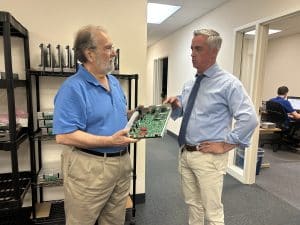Cyber charters — the virtual charter schools that just involve students logging onto a computer for their education — have never stacked up well by the standard measures. Now a new study shows that they are failing in other important ways as well.
Cyber Charter History
Distance learning has been around for decades. I have memories of trying to coax sound and video out of a sputtering phone connection so that my class could have a class with a teacher on the other end of the state. But the combination of phone and cable lines did not prove reliable. The University of Phoenix became the first institution to launch fully online bachelor’s and master’s degrees in 1989 (the same year that Apple introduced the sixteen-pound Macintosh portable for $6,500).
States started passing laws allowing charter schools in the early 1990s, and cyber charters followed soon after. Pennsylvania passed its own charter school law in 1997. The law was tweaked to include cyber charter schools in 2002, and Pennsylvania quickly became one of the leading states in the cyber charter movement.
Why is Pennsylvania the cyber charter capital of the United States? The likeliest answer is funding: while other states use a variety of formulas and oversight methods, Pennsylvania simply and generously funds cyber charters as if they were bricks and mortar charter schools. As pointed out by a 2022 report from the PA Charter Performance Center of Children First, of the 27 states that have cyber charters, none fund them as Pennsylvania does. And while other states may require cyber charters to win approval from school board members elected by taxpayers in local districts, Pennsylvania cybers need only win approval in Harrisburg.
Pennsylvania has more students enrolled in cyber charters than any other state, with that number swelling during the height of the pandemic. In 2021, cyber charters took in an estimated $980 in revenue. The Pennsylvania Cyber Charter School Association estimates the current price tag is $1.4 billion, but that assumes $10,000 per student for 144,000 students, and many of those students will be bringing even more taxpayer dollars to the cyber coffers—taxpayer dollars that have been diverted from public school systems. And a 2019 study suggests that poor districts get hit the hardest.
Meanwhile, these cyber charters are rolling in money, getting busy in the real estate business, and dropping tens of millions of dollars on marketing. Commonwealth Charter Academy paid for a huge Jerrold the Bookworm float in a Philadelphia parade, and if you’re headed to see the Wilkes Barre/Scranton Penguins, you and your group can get tickets for the CCA Ice Level Lounge.
Consider this insight offered by Kenneth Berlin, superintendent of Wattsburg School District:
“When the pandemic started, our district contracted an online learning system from K12 Learning Solutions (Stride) to offer our students an online schooling option facilitated by our teachers. Because we use our teachers and equipment, the average cost per student to the district is about $3,000. I want to note that the K12 Learning Solutions platform we purchased is the exact same platform used by Insight PA Cyber Charter School. I also want to point out that if a regular education student enrolls in Insight PA Cyber Charter School, our taxpayers are billed a mandated $13,118 per student. For special education students, the cost rises to $23,587 per student. Given that we can provide the exact same cyber learning experience as the Insight PA Cyber Charter School for just $3,000 per student, I believe that the current cyber school funding scheme is an unjustified waste of taxpayers’ hard-earned money.”
Cyber Charter Track Record
In the modern education reform era, schools are evaluated by standardized testing (in Pennsylvania, the PSSA and Keystone Exam). It’s not a great way to evaluate a school, but it’s what legislators have settled on, and all PA schools operate on that same playing field.
Cyber charters have turned in universally lousy results.
Nationally, studies of cyber charters have repeatedly found the same results—that cyber charters fail to make the grade. The Center on Reinventing Public Education (CREDO) and Mathematica Policy Research are two organizations that generally support school choice and charter schools. Yet their 2015 study of national cyber charters rang huge alarm bells, declaring that cyber charters didn’t just fail to live up to the work of other brick and mortar schools, but have an “overwhelming negative impact.” Online students, they found, lost nearly half a year’s worth of attainment in English; as for math, the students might as well not have been in school at all.
Even the National Alliance for Public Charter Schools, the National Association of Charter School Authorizers, and choice advocacy group 50CAN have called for cyber charters to be drastically improved.
Nationally, cyber charters have also shown problems with accountability and oversight. In 2019, the74, a website that is generally supportive of school choice policies, uncovered a disturbing pattern of cyber charter companies using nasty accusations and underhanded stunts to fight off attempts to shut down failing cyber schools. In Ohio, it took years to catch the Electronic Classroom of Tomorrow (ECOT) cooking its books, then more time to get it shut down. Indiana also had a major scandal (which they found because they require annual audits), and the legislature passed some reforms to tighten the rules. California’s huge A3 scandal has led to a moratorium on new cybers, now in place until 2025.
Pennsylvania has seen many of the same issues.
In 2019, the Philadelphia Inquirer found that a whopping 10 out of 15 cybers were operating without a current state charter. In December of 2020, an investigation by the Scranton Times-Tribune found that six of the 14 cyber charters had never been reviewed by state auditors, and others had been audited only once (charters report their own audits to the state). Nor are there any standard metrics for how the schools count attendance (like a single log-in per day or per week? X number of hours spent on the program?).
When Nicholas Trombetta used Pennsylvania Cyber School to funnel $8 million tax dollars to himself, it was federal authorities and not the state that finally caught him.
And as far as test scores go, Pennsylvania’s cyber schools range from poor to terrible. In 2018-2019, the last COVID-free year, none of the cyber charter schools beat the state average of 62.1 percent proficient for English or 45.2 percent for Math. A couple were almost in the neighborhood, but some were not remotely close. Agora Cyber was 34 percent English, 10.6 percent Math. Insight PA Cyber was 28.5 percent English, 7.6 percent Math. And Commonwealth Charter Academy, the 800-pound gorilla of PA cybers, the business that spent $19 million for advertising over just two years – their scores show 5 percent English, and 13.5 percent Math.
That is not a recent issue. Between 2013 and 2016, no cyber school ever achieved a “passing” grade.
What if we use other measures?
Sarah Cordes, a policy scholar and associate professor at Temple University, noted that the literature on charter school effects seems focused primarily on test scores, and so she set out to add to the literature in the field by looking at other impacts of charter schools, particularly those that point to long-term effects.
There are economists out there who insist that test scores correlate to life earnings, but their research is highly debatable. Even among some education reformers, the notion that raising a student’s test score will improve their life outcomes is a discredited idea, lacking evidence and sense.
So Cordes research looks at other outcomes, including high school graduation and post-high school enrollment. Her paper (with the not very sexy title “Cyber versus Brick and Mortar: Achievement, Attainment, and Postsecondary Outcomes in Pennsylvania Charter High Schools”) offers some intriguing results.
Brick and mortar charter results mirror previous research; basically, some positive effects in certain situations.
Briefly, I find that brick and mortar charter schools have positive or no effects across all outcomes and that these positive effects are concentrated among Black and economically disadvantaged students, and students living in urban districts.
But for cyber charters, the results were worse than both public schools and brick and mortar charter schools.
Cyber student demographics are similar to public school demographics, though she found cyber students less likely to be, more likely to have repeated a grade, more likely to have lower tests scores, and more likely to have a high rate of absenteeism. The last will come as no surprise to teachers who have witnessed the phenomenon of students going to cyber school to avoid getting in trouble for truancy.
It is fair for cyber schools to point out that they enroll many students who have a history of not “doing school” well. But helping those students get an education is supposed to be the cyber school specialty. After a couple of decades, they do not appear to have mastered the necessary strategy.
When it comes to achievement, Cordes found what many others have found — cyber students come up with lower scores. On paper, cyber students appear to have significantly better attendance than students in other schools, but as she notes, cyber school attendance is measured differently. If, for instance, all a student needs to do to count as “present” is simply log on to the program, that “present” doesn’t tell us much about the student’s attendance that day (not even whose fingers were on the keyboard when logging in).
While Cordes finds that brick and mortar charters increase the likelihood that students will move on to college (interestingly, she identifies a “shift” in plans from two year to four year schools), cyber schools have the opposite effect. Cordes worked with comparisons of 8th grade students from the same school, with similar test scores, who moved on to different types of schools in 9th grade.
Students who enroll in a cyber charter school are 9.5 percentage points less likely to graduate, 16.8 percentage points less likely to enroll in a postsecondary institution, 15.8 percentage points less likely to enroll in a 4-year institution, and 2.3 percentage points less likely to enroll in a 2-year institution.
These are not good numbers, and Cordes is not alone in finding them. The Education Week Research Department found in 2019 that only 37 percent of all virtual charters had graduation rates of 50 percent or above.
Cordes finds that the effects of brick and mortar charters land differently across different demographics, with benefits coming particularly to Black and Hispanic students, the negative effects of cyber charters are distributed across all racial and income groups. Success for brick and mortar charters is primarily an urban phenomenon, while cyber charter failure is everywhere, with little or no variation by location.
The bottom line
I asked Cordes via email what she considered the most important point to take away from the study. She replied:
“I would say the most important takeaway is that students attending cyber charter schools have worse outcomes than students in both traditional public and brick and mortar charter schools. Importantly, this extends beyond just having worse test scores, as I find that students who enroll in cyber charter schools are less likely to graduate high school and enroll in college, both of which matter for later life outcomes like employment and earnings.”
The Wolf administration tried hard to push cyber charter reforms. They were unsuccessful, and it’s not yet clear if the Shapiro administration intends to pick up that fight. But this new study underlines what research has shown us over and over again. While virtual schooling works for a handful of students, on the whole, Pennsylvania taxpayers are overpaying for a form of schooling that simply does not deliver the results that even approach what we get from our public school system.
It’s long past time for serious reform of Pennsylvania’s virtual schools.







